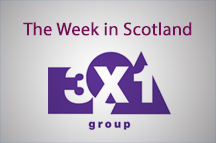 So, Scotland’s electoral hamster wheel has had another frenetic spin with yesterday’s local council vote. And just as elsewhere in the UK the big loser is the Labour Party, with the Tories the major winner.
So, Scotland’s electoral hamster wheel has had another frenetic spin with yesterday’s local council vote. And just as elsewhere in the UK the big loser is the Labour Party, with the Tories the major winner.
Inevitably these local elections are expected to be an indication of how Scotland might vote in next month’s general election and a bellwether for support for Scottish independence.
At the time of going to print (albeit digitally) we are still awaiting the final outcome. Unlike elsewhere in the UK, counting doesn’t begin north of the border until the morning after.
So, we have to wait until the late afternoon into the early evening before we get the definitive picture on the Scottish local authority map.
Which means after a Labour collapse in the English and Welsh council elections, final confirmation of Jeremy Corbyn’s bad news from north of the border is simply in the post.
For Labour and the SNP all eyes have been on the big prize of control of Scotland’s largest and most iconic council – Glasgow.
Glasgow City Chambers has been a Labour stronghold since 1945, often referred to as Scotland’s Kremlin.
But results so far from the Glasgow count show that vice-like Labour grip is no more as they lost overall control of the city.
With the SNP riding the crest of a clean sweep of Glasgow seats in the 2016 Holyrood and 2015 general elections, Nicola Sturgeon had hoped she could scoop up the magic number of 43 seats to be the majority party.
But that is unlikely as news broke that the Tories had unexpectedly taken a seat in the east end ward of Shettleston. So it’s looking likely that the SNP are set for minority rule in what used to be Red Clydeside.
In nearby North Lanarkshire a Tory councillor has even been returned in Ravenscraig, where the iconic steelworks was closed in the 80s under Margaret Thatcher.
With just a month till the general election and with the Conservatives having made huge gains in the local elections south of the border, most commentators anticipated big gains for Ruth Davidson’s party across Scotland’s 32 city and town halls.
The question was, could the Tories build on their May 2016 Scottish Parliament result when they had a stunning haul of 31 seats to Labour’s 24 to become the official opposition at Holyrood?
As things stand in mid-afternoon, the Conservatives are up 103 seats on their 2012 showing, while Labour are down 68.
While the SNP will be hoping that with 9 councils still to declare they will gain seats, at the moment they are, in fact, 17 seats down on 2012.
Results at the moment suggest Ruth Davidson’s party are winning support in a big way from Labour, but potentially also from the Lib Dems and possibly even the SNP.
Nicola Sturgeon’s SNP have been the dominant party at Holyrood. And let’s not forget they won 56 out of 59 seats in 2015. But they only had overall control of just two councils after the 2012 council vote – Dundee and Angus.
Most observers still believe that while the SNP gains are not as big as they would have liked, they could emerge this evening as the largest party in as many as to half of Scotland’s 32 councils.
So, while there’s no doubting that the single transferable voting (STV) system for Scottish councils makes it a hard task for parties to win overall control, it’s highly probable that SNP councillors will be the senior partner in potential coalitions and working arrangements the length and breadth of our towns and cities.
Additionally, STV, where a party can win a seat in a multi-member ward with not much more than 20 per cent of the vote, makes it difficult to extrapolate to the first-past-the-post Westminster voting system.
That means the big question is whether the gains the Conservatives have enjoyed this week will be replicated when we all get a chance to do it all again on 8 June, when voters in Scotland have the joy of their seventh election in just 38 months!
One thing is for sure – the General Election north of the border will be a two way fight between the SNP and Scottish Conservatives.












